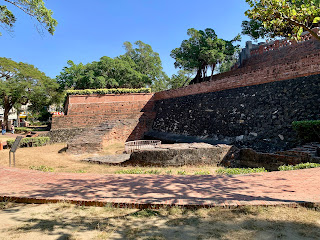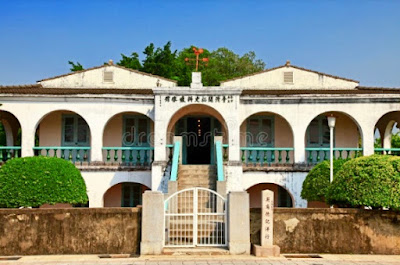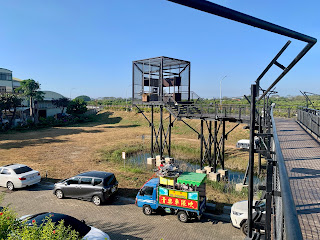8th - 9th Dec 2023
 |
| A Nativity scene in Tainan. |
The train journey from Taipei to Tainan, about ⅔ the way down the west coast, took 3hrs10mins. Taiwan Rail have 'slow' trains which stop at numerous small towns, high speed trains which stop at the main stations and, I believe, new 'bullet' trains (300+ kmph jobs).
I took one of the 'high speed' trains (as per left). It left on time at 10.00am, stopped at a couple of major towns, and arrived on time at 1.10pm. It was reasonably comfortable. You are allocated a seat, and it was fairly full up. As with the Metro they have electronic notice boards on board which tell you, both in Chinese and English, which station you are approaching, when you will arrive and what the next stop is. Plus other info. All most informative.
For the first hour and a half we travelled through end-to-end industrial jungles and accompanying, rather grotty, residential apartment blocks. Taiwan's industry is huge. About halfway down the west coast, beyond Changhua, we hit arable land (large rice-fields and other crops). The flat coastal area extends for about 20 miles inland from the sea to the mountains. It was pretty boring scenery and the only animals I saw were at a farm we passed with a paddock containing about a dozen black & white cows (Friesians?).
There was, as at almost every transport hub here, a most helpful 'Customer Information Office' at the Tainan main station (you just don't get those in UK) where I picked up a good street map and got useful info on where to go and what to see. I walked from the station to the 'hotel' I had booked, the Leo Ho. It was down a small alleyway 10 minutes walk from the station. There was a problem. It was one of those places without a 'reception', of which I was unaware when I booked. Unbeknown to me, I had been expected to receive, by e-mail, an entry code to get in and for entry to my room! Most of the time I had either not been connected to the internet or had missed the vital message. By good fortune I met a very helpful 'guest' (thanks Vincent!) who spoke good English and a lady arrived who worked there. She eventually gave me a key fob to get me in and to keep. They were very charming and helpful and if I hadn't met them I might have ended up sleeping on the street! Beware hostelries without 24 hour receptions! As it happened the accommodation was very comfortable with all mod-cons and at a very reasonable price (being 'thrifty' I do go for cheap options).
The main city itself is smart and elegant. It boasted very upmarket shops; fashionable clothes shops, electronics and computers (obviousy), lots of wristwatch and spectacles emporia and, surprisingly, many top-of-the-range ladies' (and gents') hairdressers! The population here do take great care about their appearance. The same might not be said of my home town where fast food outlets and tattoo parlours shape the size and appearance of many locals.
There were again, as described in my last post on Taipei, an amazing proliferation of 7Eleven and Family Mart mini-supermarkets. I still can't get my head around why they have so many...but they are certainly 'convenient'.
One significant aspect of arriving here was the change of climate. From the rather cool and drizzly Taipei (maybe it has changed since I left) I was now bathed in the sun and warmth. The temperature was in the mid to high 20s with blue skies.
I went to a decent bar that evening, 'Legends' which was within easy staggering distance from my 'hotel'.
Right: It had a Pool table and I had a game with a local. Needless to say I lost comprehensively, but it was all good fun and he was modest in his easy victory!
The most interesting and oldest part of the city is Anping which is around the port area at the far west end. This place has a remarkable history and takes up the rest of my report. The Dutch colonised this area in 1624 and called it Zeelandia. They built a fort there, and it became a major trading post for them. As it happened, the Spanish colonised the north end of Taiwan (known as Formosa in those days) in 1626. 'Formosa' was up for grabs!
There is no Metro system in Tainan so it was a slow (50min) bus ride (traffic light delays every 100yds) to Anping. On walking from the bus stop I passed an old Dutch gun emplacement (left) with some cannons still in place.
Right: .......and a very extensive Buddhist cemetery.
Left: ......and past the gates to the splendid and elaborate Buddhist Anping Mazu Temple.
Right: Behind this was a large street market which, as well as the normal plethora of food stalls, were several 'games' stalls such as this mini-shooting gallery. These seem very popular at all the street markets and use air-powered weapons firing plastic pellets at, in this case, small balloons. The young girl here was a dead-eye Dickette, and won a prize!
Right. Behind the market is the Dutch fort. Actually there is hardly anything left of it. The tower in the centre is, or was, known as the Scouting Deck, originally built in 1945 to keep an eye on the port, and rebuilt in 1975.
Right: You can climb to the top, which of course I did, and get a view over the City. This, not very impressive view, is towards the main City to the east.
Left: Banyan (fig) trees surround a 'pavilion' at the top. This was not Dutch, in fact it was built by the Japanese as a residence or accommodation for visiting VIPs. It now houses a not very interesting museum. Banyan trees feature largely in this part of the world.
Right: Part of an original Dutch wall.
Right: Old 17th century cannon lying around the outside. I suspect with replacement wheels and carriage.
The story continues. A Chinese General, Koxsinga, who was a big cheese in the Chinese Ming Dynasty, led an attack on the Dutch colony in 1661. He laid siege to the fort area and the Dutch finally surrendered in 1662. Koxinga was helped by the indigenous natives who sided with him and rather brutally set about murdering many Dutch. I don't know what happened to the Spanish in the north.
Koxinga had this memorial (right) erected at the fort to celebrate his victory. He died 2 months later, aged 37, of malaria. Some reports said that he went mad. Anyway, the Chinese now ruled Taiwan and, I think, it then came under the auspices of the Quing Dynasty, but I get my Mings and Quings rather muddled up (sounds painful!). Tainan, then called Tayouan, became the capital city of Taiwan. It is where Taiwan got it's name from.
In the centuries that followed the Chinese encouraged other nations to base trading stations on the island. It benefitted the Chinese to do so. Indeed the British (East India Company) did just that. Tait & Co, along with several other companies, established a large business there trading in tea, camphor and opium, as well as financial services. This happy arrangement continued until the Japanese invaded the island in 1895.
North of the fort is a street which contains a). many very narrow buildings in the Dutch architectural style (as in Amsterdam) b). the Tait & Co Merchant Building and c) a popular tourist site, the Tree House.
Left: The elegant Tait & Co Merchant House. It is now a museum displaying the lifestyles of the Dutch, Chinese and indigenous peoples in the 19th century.
Next door is the Tree House. This was originally a storehouse for Tait & Co. It was then used by the Japanese to store salt. It fell into disuse and disrepair and was grown over, indeed swallowed up, by the very invasive Banyan trees (right). I wouldn't want one in my garden...although the jungle state it is in at the moment I don't suppose anyone would notice.
There are many wooden walkways (left) which take you through and over the Banyan branches, plus a rather good café.
Good hot coffee is hard to come by in this country. The locals like sweet iced tea.
Right: An aerial walkway which takes you out to the north.......
Left: ....for a view over the wet estuary area from which the Japanese extracted salt, and stored it in this house.
There is a plaque on the railing here written in Chinese. They speak and write old classic Mandarin Chinese in Taiwan (China has developed a simplfied written script I believe). It is incredibly complex to any foreigner's eyes. It used to be written vertically starting at the left hand corner. It is now written lengthwise; more practical for signage I suppose!
This plaque, part of which I show here, apparently (because my Classic Mandarin is a bit sketchy) describes something to do with the salt manufacture. The 'character' 7th from top left and repeated 3 times in the bottom row, is simply the word 'salt'. It would take me 5 minutes to draw it. Amazingly the locals can scribble this as quickly and legibly (to them) as we can in Roman script. I have no idea how they begin to learn to write this language!
Left: Bicycles are popular. They have numerous stands of these 'pay by card' bikes all over the city. There is a kind of credit card here called a T-Card which you can use for these and all other public transport throughout the country with no time consuming need to buy tickets A very simple and efficient system. A bit like a universal Oyster Card.
Right: Some colourful sweetmeats on sale. They were put into a drink. I didn't try it.
That is quite enough about Tainan. I am off to visit a 'hot springs' area in the hills north-east of here next. In fact, as you read this I will have been there and two other places since. I can't keep up!
Left: This is my name written for me in Classic Mandarin by a local I met in a bar. Or at least I was told it is. It might mean something very rude. I must check!






















No comments:
Post a Comment